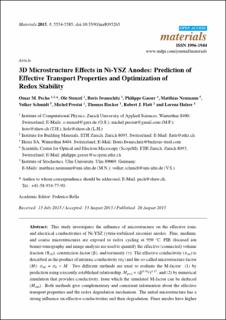Please use this identifier to cite or link to this item:
https://doi.org/10.21256/zhaw-1476Full metadata record
| DC Field | Value | Language |
|---|---|---|
| dc.contributor.author | Pecho, Omar M. | - |
| dc.contributor.author | Stenzel, Ole | - |
| dc.contributor.author | Iwanschitz, Boris | - |
| dc.contributor.author | Gasser, Philippe | - |
| dc.contributor.author | Neumann, Matthias | - |
| dc.contributor.author | Schmidt, Volker | - |
| dc.contributor.author | Prestat, Michel | - |
| dc.contributor.author | Hocker, Thomas | - |
| dc.contributor.author | Flatt, Robert J. | - |
| dc.contributor.author | Holzer, Lorenz | - |
| dc.date.accessioned | 2017-11-30T14:48:08Z | - |
| dc.date.available | 2017-11-30T14:48:08Z | - |
| dc.date.issued | 2015-08-26 | - |
| dc.identifier.issn | 1996-1944 | de_CH |
| dc.identifier.uri | https://digitalcollection.zhaw.ch/handle/11475/1629 | - |
| dc.description.abstract | This study investigates the influence of microstructure on the effective ionic and electrical conductivities of Ni-YSZ (yttria-stabilized zirconia) anodes. Fine, medium, and coarse microstructures are exposed to redox cycling at 950 ºC. FIB (focused ion beam)-tomography and image analysis are used to quantify the effective (connected) volume fraction (Φeff), constriction factor (β), and tortuosity (τ). The effective conductivity (σeff) is described as the product of intrinsic conductivity (σ0) and the so-called microstructure-factor (M): σeff = σ0 x M. Two different methods are used to evaluate the M-factor: (1) by prediction using a recently established relationship, Mpred = ε β^0.36/τ^5.17, and (2) by numerical simulation that provides conductivity, from which the simulated M-factor can be deduced (Msim). Both methods give complementary and consistent information about the effective transport properties and the redox degradation mechanism. The initial microstructure has a strong influence on effective conductivities and their degradation. Finer anodes have higher initial conductivities but undergo more intensive Ni coarsening. Coarser anodes have a more stable Ni phase but exhibit lower YSZ stability due to lower sintering activity. Consequently, in order to improve redox stability, it is proposed to use mixtures of fine and coarse powders in different proportions for functional anode and current collector layers. | de_CH |
| dc.language.iso | en | de_CH |
| dc.publisher | MDPI | de_CH |
| dc.relation.ispartof | Materials | de_CH |
| dc.rights | http://creativecommons.org/licenses/by/4.0/ | de_CH |
| dc.subject | Electrode | de_CH |
| dc.subject | Fuel cell | de_CH |
| dc.subject | Map | de_CH |
| dc.subject | Microstructure | de_CH |
| dc.subject.ddc | 540: Chemie | de_CH |
| dc.subject.ddc | 621.3: Elektro-, Kommunikations-, Steuerungs- und Regelungstechnik | de_CH |
| dc.title | 3D microstructure effects in Ni-YSZ anodes : prediction of effective transport properties and optimization of redox stability | de_CH |
| dc.type | Beitrag in wissenschaftlicher Zeitschrift | de_CH |
| dcterms.type | Text | de_CH |
| zhaw.departement | School of Engineering | de_CH |
| zhaw.organisationalunit | Institute of Computational Physics (ICP) | de_CH |
| dc.identifier.doi | 10.3390/ma8095265 | de_CH |
| dc.identifier.doi | 10.21256/zhaw-1476 | - |
| zhaw.funding.eu | No | de_CH |
| zhaw.issue | 9 | de_CH |
| zhaw.originated.zhaw | Yes | de_CH |
| zhaw.pages.end | 5585 | de_CH |
| zhaw.pages.start | 5554 | de_CH |
| zhaw.publication.status | publishedVersion | de_CH |
| zhaw.volume | 8 | de_CH |
| zhaw.publication.review | Peer review (Publikation) | de_CH |
| Appears in collections: | Publikationen School of Engineering | |
Files in This Item:
| File | Description | Size | Format | |
|---|---|---|---|---|
| 2015_pecho_3D microstructure effects in Ni-YSZ anodes.pdf | 8.93 MB | Adobe PDF |  View/Open |
Show simple item record
Pecho, O. M., Stenzel, O., Iwanschitz, B., Gasser, P., Neumann, M., Schmidt, V., Prestat, M., Hocker, T., Flatt, R. J., & Holzer, L. (2015). 3D microstructure effects in Ni-YSZ anodes : prediction of effective transport properties and optimization of redox stability. Materials, 8(9), 5554–5585. https://doi.org/10.3390/ma8095265
Pecho, O.M. et al. (2015) ‘3D microstructure effects in Ni-YSZ anodes : prediction of effective transport properties and optimization of redox stability’, Materials, 8(9), pp. 5554–5585. Available at: https://doi.org/10.3390/ma8095265.
O. M. Pecho et al., “3D microstructure effects in Ni-YSZ anodes : prediction of effective transport properties and optimization of redox stability,” Materials, vol. 8, no. 9, pp. 5554–5585, Aug. 2015, doi: 10.3390/ma8095265.
PECHO, Omar M., Ole STENZEL, Boris IWANSCHITZ, Philippe GASSER, Matthias NEUMANN, Volker SCHMIDT, Michel PRESTAT, Thomas HOCKER, Robert J. FLATT und Lorenz HOLZER, 2015. 3D microstructure effects in Ni-YSZ anodes : prediction of effective transport properties and optimization of redox stability. Materials. 26 August 2015. Bd. 8, Nr. 9, S. 5554–5585. DOI 10.3390/ma8095265
Pecho, Omar M., Ole Stenzel, Boris Iwanschitz, Philippe Gasser, Matthias Neumann, Volker Schmidt, Michel Prestat, Thomas Hocker, Robert J. Flatt, and Lorenz Holzer. 2015. “3D Microstructure Effects in Ni-YSZ Anodes : Prediction of Effective Transport Properties and Optimization of Redox Stability.” Materials 8 (9): 5554–85. https://doi.org/10.3390/ma8095265.
Pecho, Omar M., et al. “3D Microstructure Effects in Ni-YSZ Anodes : Prediction of Effective Transport Properties and Optimization of Redox Stability.” Materials, vol. 8, no. 9, Aug. 2015, pp. 5554–85, https://doi.org/10.3390/ma8095265.
Items in DSpace are protected by copyright, with all rights reserved, unless otherwise indicated.